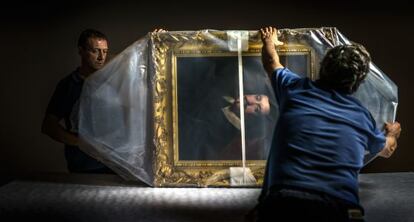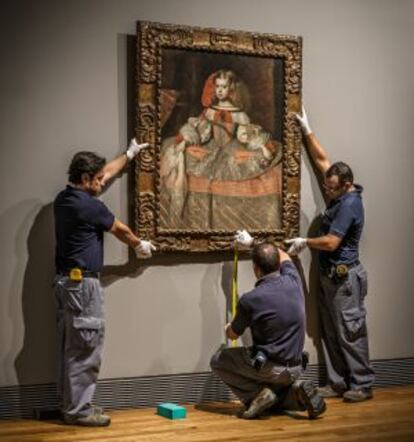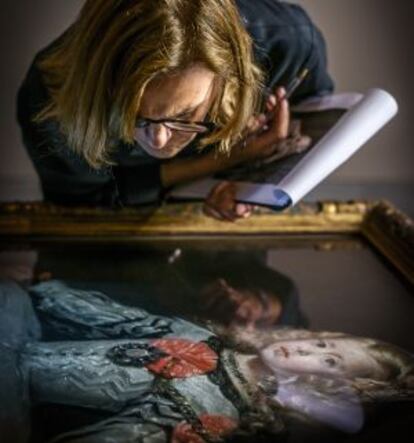The homecoming
The Prado's fall show features seven Velázquez portraits sent to the Austrian court 350 years ago

Given the circumstances, the girls looked fabulous. A wrinkled dress, a furrowed brow, anything of that nature would have been understandable following their 60-hour road trip between Vienna and Madrid. But there they were, looking completely unfazed, defiant even, in the face of the enormous expectation created around the exhibition Velázquez and the Family of Philip IV. Four weeks ago, around 20 people including curators, technicians, restorers, reporters and photojournalists, stood inside the Prado Museum anxiously awaiting the historical moment when the paintings of the infantas Margarita and María Teresa, Queen Mariana of Austria and poor little Felipe Próspero, who died at the age of three, would return to their original home.
The seven portraits - five by Diego Velázquez and two by his disciple and son-in-law Martínez del Mazo - were returning together for the first time some 350 years after being sent to the Austrian court by the genius from Seville. Since 1923, their home has been the Kunsthistorisches Museum in Vienna, where they departed from on September 23 inside sophisticated crates and under extraordinary security measures. The royals spent two nights in the parking lots of as many motels in Milan and Barcelona, which may not sound sufficiently grand for such illustrious guests, but provided a better cover of anonymity than the more fashionable downtown establishments.
Several National Police patrol cars and an assorted group of Prado workers were waiting for the cortège , looking understandably edgy because of the responsibility of this momentous event. When it did arrive, the artwork was quickly spirited into the building and brought to an area that was renovated by the architect Rafael Moneo, where they will hang until January 9, attracting the admiration of all the local fans of the genius from Seville; with any luck, this show prove to be as successful as the historical Velázquez exhibition of 1990, which broke all attendance records and became a must-see event.
But before going up on the wall, the oil paintings had to rest for 48 hours inside their crates, as preventive restoration science mandates. "It is essential for them to get acclimatized to their new temporary home," explained Carmen Morais, the exhibition coordinator, before ordering everyone in the room to leave the weary travelers alone.
Five were by Diego Velázquez and two by his disciple and son-in-law Del Mazo
Javier Portús, chief of the Spanish painting department, curator of the show on Velázquez's last period and a man whose erudition is positively infectious, arrived early on the day when the paintings were set to be taken out of their crates and put up on display. "This is the best moment of all, the most exciting one, in the whole arduous process that goes into preparing a show," he explained, standing in front of the famous Dorset Meninas, a copy of the famous Meninas attributed to Martínez del Mazo.
The day's agenda was set out with meticulous precision. The artworks emerged from their protective wrapping under the watchful eye of two experts, one from each of the museums involved. A restorer acted as the Prado representative, while the protocol says that one or several emissaries from the lending gallery may travel with the works. In the industry jargon, these professionals are referred to as the "couriers."

The process was not simple. First, a team formed by museum brigades (the only ones authorized to transport the artwork) and technicians from the company hired to mount the show carefully extracted the pictorial jewels and placed them on a makeshift table consisting of two easels and a board made of something that looked like marble but wasn't heavy like the stone. Once La infanta Margarita (1653), a masterpiece of courtesan portraiture, was lying on it with the same scared look on her face as always, a smiling Herbert Reitschuler, the envoy from the Viennese museum, stepped up to the plate. He and María Álvarez Garcillán, of the Prado's restoration department, got to work. The next tandem was formed by Georg Prast, an Austrian with a rocky command of Spanish, and Elisa Mora, whom readers might remember for the restoration work she conducted on The Wine of Saint Martin's Day, an invaluable painting by Bruegel the Elder which was unearthed in 2010 at the Prado.
Both teams worked in parallel, using LED flashlights and powerful light systems to pore over the paintings in search of flaws. For instance, where was the little dog that Velázquez captured in a few indolent brushstrokes? This was in fact no joking matter, as the little animal was one of the few members of the court of Philip IV that the Spanish painter - a hermetic, mysterious man who never put his thoughts down on paper - ever expressed any affection for, as noted by Antonio Palomino in the first Velázquez biography, published in 1724.
It is essential for them to get acclimatized to their temporary home"
But there was a second, more important reason for the careful examination: if any damage has been sustained during the trip, it is important to establish that the fault lies with the owner of the painting, and not the recipient. "We rarely ever come across anything, though," said Elisa Mora in a soothing tone.
An equivalent perusal takes place one more time when the art on loan is about to be returned to its owner. The procedure is reminiscent, albeit at a much more pedestrian level, of the way rental cars get inspected for bumps and scrapes. These art experts scrutinize the paintings knowingly, then exchange mysterious phrases in a low voice and make notes on a document. This piece of paper records information such as the exact size of the piece or the duration of the loan. It also incorporates a diagram that rigorously replicates any faults found with the canvas and the frame (cracks, peeling paint and so on).

Should the outside observer be so utterly tactless as to inquire whether all this checking is a requirement made by the insurance companies (in this case, the state), which back these loans with vast amounts of money, the curator Portús - whose field of operation lies somewhere between the coldness of science and the warmth of beauty- would reply: "What matters is the integrity of the works; our responsibility is to ensure that they continue to inspire mankind for centuries to come."
Shortly before this same expert had expressed admiration at the fact that the Kunsthistorisches agreed to remove the glass covering four of the seven paintings on loan. In this, as in all other aspects of old painting, there are several schools of thought, and the Prado belongs to the category of museums that prefer, whenever possible, not to place any barriers, no matter how transparent, between the visitor and the paintings' secrets.
Both teams worked in parallel, using LED flashlights in search of flaws
And in this case, it is something to be grateful for: there are few greater pictorial pleasures than to look down on the abyss of the artist's brushstroke, so brilliant in the lightness of its touch, without any reflections getting in the way. This, believes Portús, is the only way to appreciate Velázquez's art in all its splendor. In the last decade of his career, which these paintings belong to, the artist reached full artistic maturity. The masterpieces followed one another with astounding regularity, and necessity became a virtue (and let's admit it, Velázquez was not exactly a slave to his work): the painter infused new meaning into the concept of the unfinished work, as evidenced by the sensational portrait of the Infanta María Teresa, on loan from the Metropolitan in New York. The young girl's hair, as wild as Habsburg genetics mandated, displays an amazing succession of butterfly adornments that crawl back into the original chrysalis, depicted as a simple stain that looks like a precursor of impressionism.
Sylvia Feryno of the Kunsthistorisches Museum arrived in Madrid a week and a half after her charges, to represent the Viennese gallery at the official opening and to underscore with her physical presence what she had proclaimed some days earlier on the phone: "This is a very special occasion. We never loan the entire lot like that: in fact, we have chosen to close off the space it usually occupies, as it would be useless to try to fill up a hole that size."
In exchange, the Kunsthistorisches Museum will get help from the Prado with the organization of a Velázquez exhibition of its own that will also travel to the Louvre later. "Vienna and Madrid have once again partnered through cultural diplomacy," added Prado director Miguel Zugaza.
This is by no means the first time that the young royals are used as currency. "In the 16th and 17th centuries, relations between the Austrian and Spanish lines of the House of Habsburg were conditioned by a complex web of conjugal relationships that served to secure political and confessional interests shared by both branches," writes the scholar Andrea Sommer-Mathis in the show catalogue. This trend, which began with Charles V, "the last monarch to rule over the entire empire," became more marked in the 1640s under Philip IV, who had just lost his first wife María and headed a bankrupt institution at war with Portugal and France; the monarchy was also desperately seeking an heir after the death from smallpox of 16-year-old Balthasar Charles. This new heir would not come until 1661, with the birth of Charles II.
Our duty is to ensure that they continue to inspire man for centuries"
The historical background to the exhibition begins with the king's second marriage in 1649 to Mariana of Austria, who had in fact been engaged to Balthasar Charles. Philip IV was also her maternal uncle. A wedding of such import required the inestimable assistance of Velázquez, the court painter. The event caught him in Rome, during the second of his much-appreciated Italian stays, experiencing great success as the official artist of the court of Pope Innocent X.
The painter had no choice but to return to Madrid, where he was presented with a long list of demands for courtesan portraits meant to be sent to people such as Emperor Ferdinand III, father of the new queen consort. "Velázquez had a monopoly over that work," recalls Portús. "This, joined to the fact that he was a painter who did not paint much and who also had to see to his other job as a landlord, resulted in a great production by his workshop."
At that point, the Infanta María Teresa was the most desired object of European matrimonial policy, and a multitude of portraits were made of her for promotional purposes. She was being courted by Ferdinand IV of Austria, by the Archduke Leopold William, and by the man who would ultimately become her husband, Louis XIV, the French king at war with Spain. In an era without Facebook, everyone wanted portraits "able to duly illustrate the lady's physical qualities," as the catalogue points out.
The dynastic intrigues also affected little Margarita, born to Philip IV and Mariana. With so many paintings being produced and sent out, it is hardly any wonder that the stars of Las Meninas would be old hands at sitting for the artist. One of the most noteworthy of the seven paintings on loan is the last of the "three paintings that the Spanish king sent to Vienna to promote the girl." In this particular portrait, she is wearing blue. The child was engaged to Emperor Leopold I at the age of nine. Given the circumstances, the fiancé had to wait around for a few years, finding solace in the contemplation of this painting.
And what about Philip IV? As he got older, the monarch stopped enjoying seeing himself captured on canvas. His relationship with Velázquez spanned nearly four decades, in what some scholars such as Jonathan Brown or Bartolomé Benassar have described as something akin to friendship. The artist made 15 portraits of the king ("he created the monarch's image for Spain and the rest of the world," notes Benassar). The last of these, painted in 1654, is part of the Prado show. It was done against his will, perhaps after having expressed in a 1653 letter that "it has been nine years since a portrait has been made of me, and I am not inclined to endure Velázquez's phlegm, because of its own sake and also so I will not see myself aging."
In 1660, six years after the royal canvas was completed, the painter died. His wife Juana Pacheco followed suit just eight days later. Perhaps it was no coincidence that the last painting to emerge from the crates at the Prado was The Painter's Family, by Juan Bautista Martínez del Mazo, who was married to Velázquez's eldest daughter and is one of the disciples whose work is also part of the Prado exhibition, along with that of Juan Carreño de Miranda. Both of them took Spanish portraiture in different directions following the death of the master. But any attempt at comparing him with his pupils is detrimental to the latter, as evidenced by the Dorset Meninas and the original masterwork by Velázquez, which functions as the centerpiece of the show.
When the technicians finished hanging the family portrait, the room began emptying of people and returning to its ideal ambient state: "Between 18 and 20 degrees Celsius, with a controlled humidity of 50 to 55 percent," as explained by the exhibition curator, Carmen Morais, for whom this moment represented the end of a long tunnel of work spent doing paperwork, requesting permits and resolving logistical sudokus.
The pinewood crates that contained the masterpieces were then taken to a warehouse outside Madrid where they are to remain until early January in the same atmospheric conditions as the Prado exhibition room: between 18 and 20 degrees Celsius, with a controlled humidity of 50 to 55 percent.
Whatever it takes to keep the royals happy.
Velázquez and the Family of Philip IV. Until February 9 at Museo del Prado, Edificio Jerónimos, Madrid. www.museodelprado.es
Tu suscripción se está usando en otro dispositivo
¿Quieres añadir otro usuario a tu suscripción?
Si continúas leyendo en este dispositivo, no se podrá leer en el otro.
FlechaTu suscripción se está usando en otro dispositivo y solo puedes acceder a EL PAÍS desde un dispositivo a la vez.
Si quieres compartir tu cuenta, cambia tu suscripción a la modalidad Premium, así podrás añadir otro usuario. Cada uno accederá con su propia cuenta de email, lo que os permitirá personalizar vuestra experiencia en EL PAÍS.
¿Tienes una suscripción de empresa? Accede aquí para contratar más cuentas.
En el caso de no saber quién está usando tu cuenta, te recomendamos cambiar tu contraseña aquí.
Si decides continuar compartiendo tu cuenta, este mensaje se mostrará en tu dispositivo y en el de la otra persona que está usando tu cuenta de forma indefinida, afectando a tu experiencia de lectura. Puedes consultar aquí los términos y condiciones de la suscripción digital.
Últimas noticias
Pinochet’s victims grapple with José Antonio Kast’s rise in Chile
Reinhard Genzel, Nobel laureate in physics: ‘One-minute videos will never give you the truth’
How Japan is trying to avert ‘digital defeat’
The complicated life of Francesca Albanese: A rising figure in Italy but barred from every bank by Trump’s sanctions
Most viewed
- Pablo Escobar’s hippos: A serious environmental problem, 40 years on
- Why we lost the habit of sleeping in two segments and how that changed our sense of time
- Charles Dubouloz, mountaineering star, retires at 36 with a farewell tour inspired by Walter Bonatti
- Trump’s obsession with putting his name on everything is unprecedented in the United States
- The Florida Keys tourist paradise is besieged by immigration agents: ‘We’ve never seen anything like this’









































